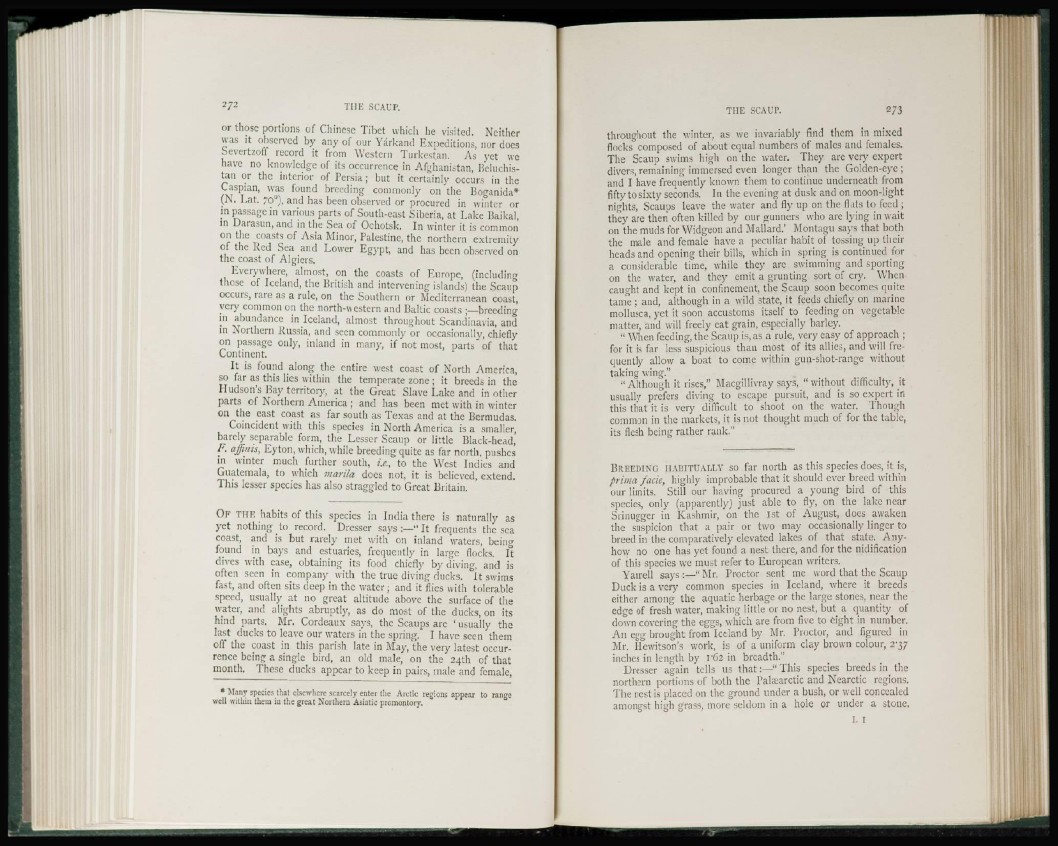
or those portions of Chinese Tibet which he visited. Neither
was it observed by any of our Yarkand Expeditions, nor does
Scvcrtzoff record it from Western Turkestan. As yet we
have no knowledge of its occurrence in Afghanistan, Beluchistan
or the interior of Persia; but it certainly occurs in the
Caspian, was found breeding commonly on the Boganida*
(N. Lat. 70°), and has been observed or procured in winter or
in passage in various parts of South-east Siberia, at Lake Baikal,
in Darasun, and in the Sea of Ochotsk, In winter it is common
on the coasts of Asia Minor, Palestine, the northern extremity
of the Red Sea and Lower Egypt, and has been observed on
the coast of Algiers.
Everywhere, almost, on the coasts of Europe, (including
those of Iceland, the British and intervening islands) the Scaup
occurs, rare as a rule, on the Southern or Mediterranean coast,
very common on the north-western and Baltic coasts ;—breeding
in abundance in Iceland, almost throughout Scandinavia, and
in Northern Russia, and seen commonly or occasionally, chiefly
on passage only, inland in many, if not most, parts of that
Continent.
It is found along the entire west coast of North America,
so far as this lies within the temperate zone ; it breeds in the
Hudson's Bay territory, at the Great Slave Lake and in other
parts of Northern America ; and has been met with in winter
on the east coast as far south as Texas and at the Bermudas.
Coincident with this species in North America is a smaller,
barely separable form, the Lesser Scaup or little Black-head,
F. affwis, Eyton, which, while breeding quite as far north, pushes
in winter much further south, i.e., to the West Indies and
Guatemala, to which marila does not, it is believed, extend.
This lesser species iias also straggled to Great Britain.
OF THE habits of this species in India there is naturally as
yet nothing to record. Dresser says:—"It frequents the sea
coast, and is but rarely met with on inland waters, being
found in bays and estuaries, frequently in large flocks. It
dives with ease, obtaining its food chiefly by diving, and is
often seen in company with the true diving ducks. It swims
fast, and often sits deep in the water ; and it flies with tolerable
speed, usually at no great altitude above the surface of the
water, and alights abruptly, as do most of the ducks, on its
hind parts. Mr. Cordeaux says, the Scaups are ' usually the
last ducks to leave our waters in the spring. I have seen them
off the coast in this parish late in May, the very latest occurrence
being a single bird, an old male, on the 24th of that
month. These ducks appear to keep in pairs, male and female,
* Many species thai elsewhere scarcely enter the Arctic regions appear to ran^e
well within them in the great Northern Asiatic promontory.
throughout the winter, as we invariably find them in mixed
flocks composed of about equal numbers of males and females.
The Scaup swims high on the water. They are very expert
divers, remaining immersed even longer than the Golden-eye;
and I have frequently known them to continue underneath from
fifty to sixty seconds. In the evening at dusk and on moon-light
nights, Scaups leave the water and fly up on the flats to feed ;
they are then often killed by our gunners who are lying in wait
on the muds for Widgeon and Mallard.' Montagu says that both
the male and female have a peculiar habit of tossing up their
heads and opening their bills, which in spring is continued for
a considerable time, while they arc swimming and sporting
on the water, and they emit a grunting sort of cry. When
caught and kept in confinement, the Scaup soon becomes quite
tame ; and, although in a wild state, it feeds chiefly on marine
mollusca, yet it soon accustoms itself to feeding on vegetable
matter, and will freely eat grain, especially barley.
" When feeding, the Scaup Is, as a rule, very easy of approach ;
for it is far less suspicious than most of its allies, and will frequently
allow a boat to come within gun-shot-range without
taking wing."
"Although it rises," Macgillivray says, "without difficulty, it
usually prefers diving to escape pursuit, and is so expert in
this that it is very difficult to shoot on the water. Though
common in the markets, it is not thought much of for the table,
its flesh being rather rank,"
BREEDING HABITUALLY SO far north as this species does, it is,
prima facie, highly improbable that it should ever breed within
our limits. Still our having procured a young bird of this
species, only (apparently) just able to fly, on the lake near
Srinugger in Kashmir, on the 1st of August, does awaken
the suspicion that a pair or two may occasionally linger to
breed in the comparatively elevated lakes of that state. Anyhow
no one has yet found a nest there, and for the nidification
of this species we must refer to European writers.
Yarrell says :—" Mr. Proctor sent me word that the Scaup
Duck is a very common species in Iceland, where it breeds
either among the aquatic herbage or the large stones, near the
edge of fresh water, making little or no nest, but a quantity of
down covering the eggs, which are from five to eight in number.
An egg brought from Iceland by Mr. Proctor, and figured in
Mr. Hcwitson's work, is of a uniform clay brown colour, 2^37
inches in length by 162 in breadth."
Dresser again tells us that:—" This species breeds in the
northern portions of both the Palxarctic and Ncarctic regions.
The nest is placed on the ground under a bush, or well concealed
amongst high grass, more seldom in a hole or under a stone.
L I